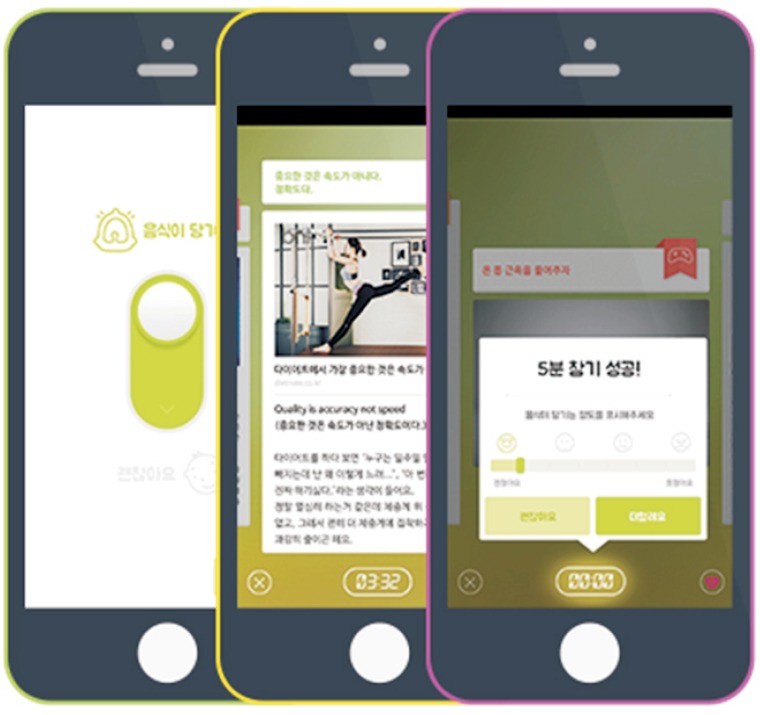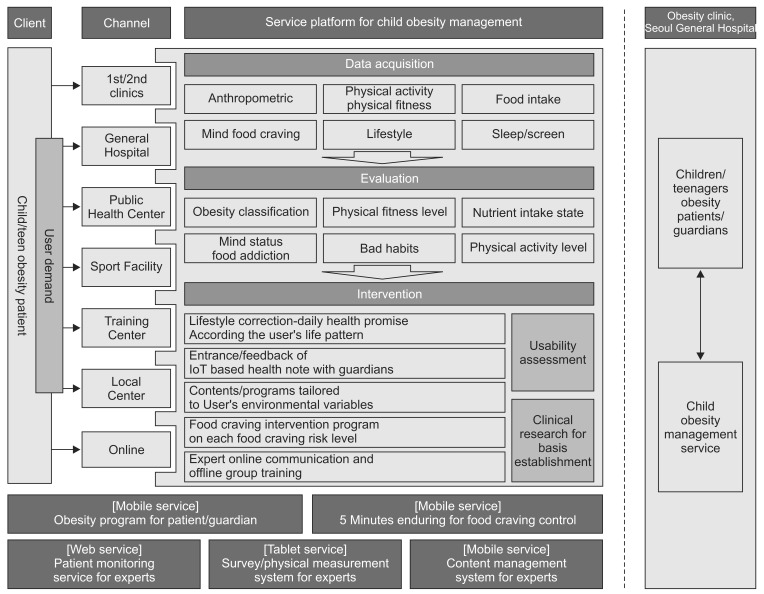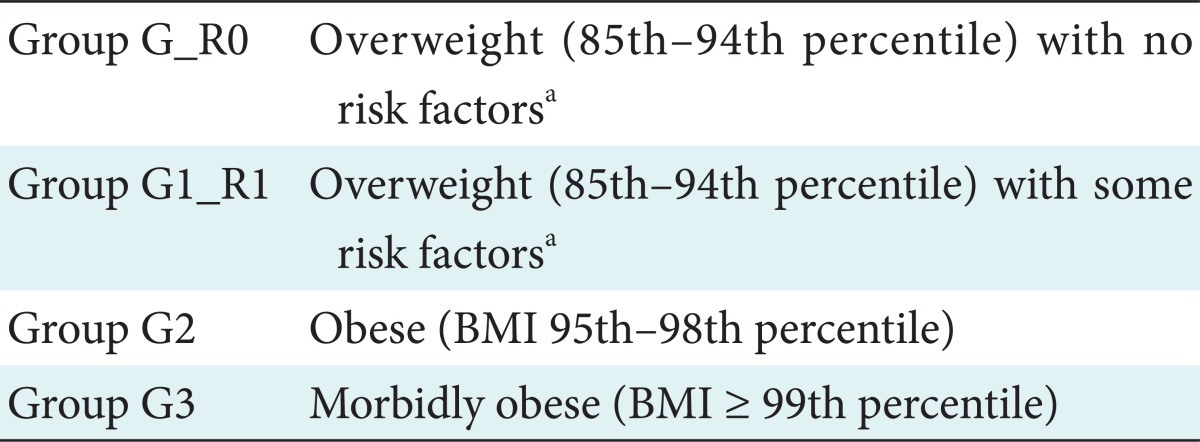 |
 |
- Search
| Healthc Inform Res > Volume 22(3); 2016 > Article |
Abstract
Objectives
This study aimed to develop an effective and efficient obesity treatment and management service platform for obese children/teenagers.
Methods
The integrated smart platform was planned and established through cooperation with service providers such as hospitals and public health centers, obese children/teenagers who constitute the service's user base, and IT development and policy institutions and companies focusing on child-teen obesity management and treatment.
A considerable amount of attention has been directed toward health management issues, specifically in relation to the concepts of well-being, wellness and healthcare [1]. Despite these efforts, however, the child-teen obesity rate is persistently increasing. According to a 2015 survey by the Ministry of Health and Welfare, one of every five children/teenagers under 19 years of age is obese, and this ratio has been increasing for the past 5 years [2]. Child-teen obesity causes various other physical and psychological issues throughout one's life, such as dyslipidemia, hypertension, cardiovascular disease, asthma, eating disorders, metabolic syndrome, depression, isolation and low self-esteem. Furthermore, the treatment cost for obesity has jumped by 82.9%, implying an expense of US $117,349,702 to society as a whole [3]. For these reasons, we should no longer neglect the seriousness of child-teen Obesity and should strive to address this issue with guidance from the government or from social institutions [45].
Following recent improvements in network environments and the popularization of smartphones, mobile healthcare services are becoming popular [678]. Various mobile healthcare services have already been introduced in Korea. In line with this trend, integrated mobile services are becoming a new issue to increase the convenience of their users [68]. However, many potential services remain unrealized due to a lack of cooperation between governments, medical staff, dieticians, sports therapists and ICT (information and communication technology) developers. Government-led projects also result in unsatisfactory outcomes not only due to the scale but to the lack of cooperation as well. For these reasons, establishing an integrated service platform is very important and is the goal of this research.
The aim of this study is to establish a more effective and efficient mobile service platform for the treatment and management of child-teen obesity by combining ICT technologies into a medical service. Research was conducted with cooperation between companies and institutions in various fields, with participants including policy institutions, clinics, general hospitals, public health centers, sports facilities, training centers, local centers, ICT planning companies, and companies involved in IT development. This service is currently being piloted at a certain general hospital located in Seoul, while more extensive applications to various teenager training programs and local health centers are planned for the future [910].
This service is based on an integrated smart platform providing content and services that are planned and established through cooperation with service providers such as hospitals and public health centers, obese children/teenagers who constitute the service's user base, and IT development and policy institutions and companies with a focus on child-teen obesity management and treatment (Figure 1).
Patients (obese children/teenagers) enter information about their activity level, exercise and meals through the health tracker and are managed by experts (medical staff members) based on the entered information. Patients are also provided with various types of information related to nutrition and exercise and communicate with responsible experts to correct improper aspects of their lifestyles that have been diagnosed through medical interviews and consultations. The parents of patients may check the information regarding their children's exercise, meals, treatment, management and other aspects of their progress through the mobile service. Experts monitor the patients in real-time based on the health information entered through the monitoring app service exclusively for that purpose and continuously communicate, providing information and interventions tailored to each patient.
Additionally, a service termed the 5-Minute Appetite Endurance Food Craving Service was planned and developed to help patients to suppress excessive impulse eating due to sudden appetite increases (Figure 2).
The target structure and a process map of this child-teen Obesity treatment service platform are summarized in Figure 3.
A child/teenager joins this service for obesity management and treatment by visiting a pediatrician for physical and body composition measurements. The expert registers the patient by entering the measurement information. The patient takes a physical fitness test consisting of various steps along with medical inquiries to detect poor health behavior and starts to wear an activity tracker. The expert provides consultations on nutrition and exercise and sets short- and long-term goals based on the test results. Later, the patient continuously uses the service by entering information about their emotions, meals and exercise. The expert then monitors this information and manages the patient's goal achievement status while the patient periodically visits the clinic for further physical measurements to check how far they have progressed toward their goal. All of the information is shared between the clinic, the patient and the parents, serving to increase the effects of the treatment.
The treatment and management program of this service is based on the principles of child-teen obesity management included in the guidelines of the American Academy of Pediatrics (AAP) for child/obesity treatment and management and the obesity treatment guidelines of the Korean Society for the Study of Obesity [3]. Interventions are classified from Stage 1 to Stage 4, with a total of four stages. Stage 4 is the most intense level of intervention (Figure 4).
Aspartate aminotransferase (AST), alanine aminotransferase (ALT), serum cholesterol, neutral fat, high-density lipoprotein (HDL) cholesterol, low-density lipoprotein (LDL) cholesterol, electrocardiogram, fasting blood glucose, hemoglobin A1c, urine and blood pressure are tested for any obese children/teenagers having a body mass index exceeding the 95th percentile for their gender and age. Lung function is tested for obese children/teenagers who are suspected of experiencing difficulty breathing during sleep. Tests for medical risks (past disease and treatment record, growth development, parents' obesity, family history, lab tests), behavioral risks (sedentary time, meal amounts, physical activity level) and attitude (interest and motivation levels for the family and the child) are conducted. The intensity and stage of intervention are set based on the results and include a mid-to-high intensity weight-control program which includes behavioral control, exercise and nutrition management aspects lasting at least one year.
The same factors are assessed for the overweight group with a body mass in the 85thŌĆō94th percentile and, if there is determined to be any health risk, a mid-to-high-intensity weight-control program including behavioral control, exercise and nutrition management is established and carried out for at least 1 year.
Management of specific groups of children/teenagers is performed by classifying the children/teenagers into four groups according to their obesity level and risk factors, as shown in Table 1.
All children/teenagers are managed from Stage 1 regardless of their group. Goal achievements are evaluated every 3 months for G1 and G2 and every month for G3. If the goal has been achieved, the stage is maintained. If the goal has not been achieved, the stage is upgraded to the next one. Stage 3 is maintained if the child has failed to achieve their goal. However, if the triglyceride glucose (TyG) index value is higher than the set point or if it is determined that an expert is required, the initial stage can be changed. Table 2 shows the intervention strategies used at each stage.
Five services, i.e., a mobile service for patients/guardians, a monitoring web service for experts, a content management system for experts, a tablet using a survey/physical fitness measurement system for experts, and the "5-minute endurance" system for food craving control were planned and developed to establish a service platform for child-teen obesity treatment and management. The development of the platform was completed successfully. The program is currently being piloted at a general hospital located in Seoul. Thus far, the service is restricted to this hospital. Therefore, research on treatment protocols and service UI/UX (user interface/user experience) enhancements by acquiring more samples will be required to develop a better understanding of these subjects. This study is expected to contribute to the establishment of future mobile platforms for healthcare services which integrate healthcare and ICT.
Acknowledgments
This work was supported by the National Research Foundation of Korea (NRF) grant funded by the Korea government (MSIP) (NRF-2013 M3C8A2A02078403).
References
1. Lee NY, Yoo SH, Lee S, Kwon O. U-healthcare service for psychological wellbeing lifecare. Korean J Bus Adm 2012;25(8):3397-3415.

2. Korea Ministry of Health and Welfare. A plan for child protection policy [Internet]. Sejong: Ministry of Health and Welfare; 2015. cited at 2016 Mar 1. Available from: http://www.mohw.go.kr/front_new/al/sal0301vw.jsp?PAR_MENU_ID=04&MENU_ID=0403&BOARD_ID=140&BOARD_FLAG=00&CONT_SEQ=322332&page=1

3. Korean Society for the Study of Obesity. Clinical practice guidelines for overweight and obesity in Korea 2014 [Internet]. Seoul: Korean Society for the Study of Obesity; 2015. cited 2016 Mar 1. Available from: http://www.kosso.or.kr/eng/

4. Kim H, Cho J, Kim S, Kang Y. Child/teenager obesity prediction research [Internet]. Seoul: Korea Institute for Health and Social Affairs; 2015. cited at 2016 Feb 20. Available from: https://research.khealth.or.kr/hpResearch/rsfileTde.dia?method=reportfile&rs_idx=961&rs_code=1502001

5. Yu G, Park J. Types of studies on smart media contents for ubiquitous health service. J Korea Des Knowl 2013;28:195-202.

6. Jeon E, Park HA. Development of a smartphone application for clinical-guideline-based obesity management. Healthc Inform Res 2015;21(1):10-20. PMID: 25705553.



7. Jeon E, Park HA. Factors affecting acceptance of smartphone application for management of obesity. Healthc Inform Res 2015;21(2):74-82. PMID: 25995959.



8. Jeon E, Park HA, Min YH, Kim HY. Analysis of the information quality of Korean obesity-management smartphone applications. Healthc Inform Res 2014;20(1):23-29. PMID: 24627815.



9. SeeMe5 [Internet]. Seoul: SeeMe5; 2015. cited at 2016 Feb 22. Available from: http://www.seeme5.org/

10. National Health Information Portal. Childhood obesity [Internet]. Sejong: Ministry of Health and Welfare; 2015. cited at 2016 Feb 12. Available from: http://health.mw.go.kr/HealthInfoArea/HealthInfo/View.do?idx=3450













